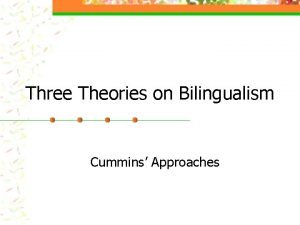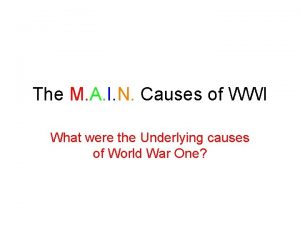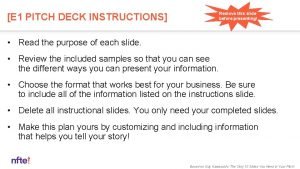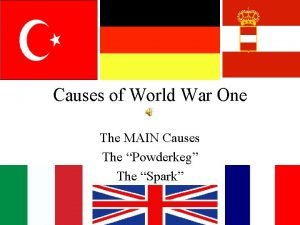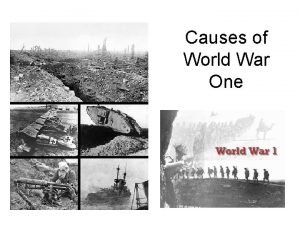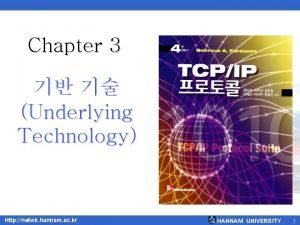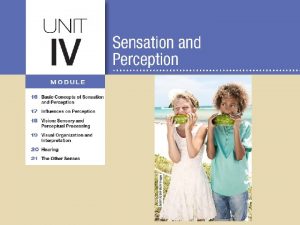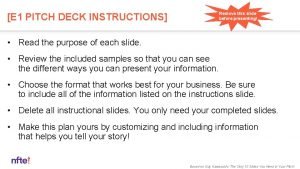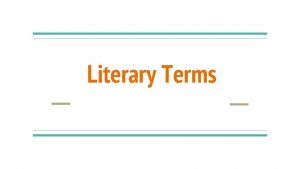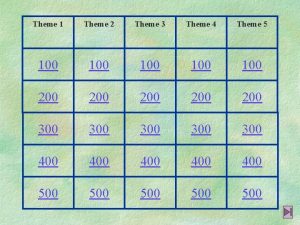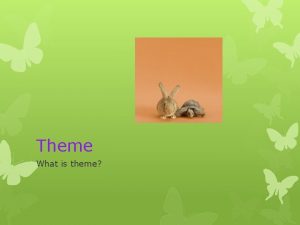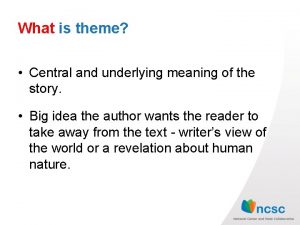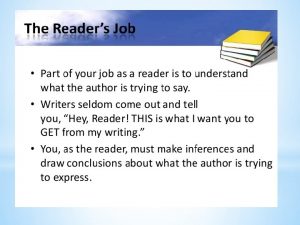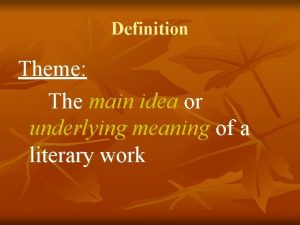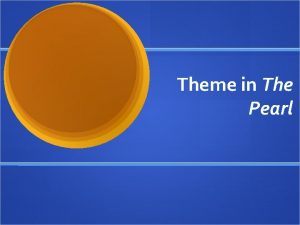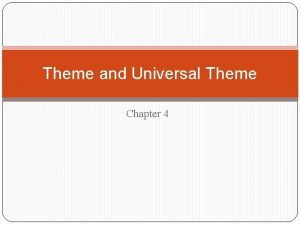Theme How to Find the Underlying Meaning and

















- Slides: 17

Theme How to Find the Underlying Meaning and Lessons in Literature Texts Limitless Learning Tutoring Teachers Pay Teachers Store © 2018 Limitless Learning Tutoring, LLC.

What is a Theme? Theme: Life lesson, meaning, moral, or message about life or human nature that is shown through a literary work. In other words… Theme is what the story teaches readers. <<Download the FREE Theme Anchor Chart now. Click here >>

Themes A theme is not a word, it is a sentence. You don’t have to agree with theme to identify it. Examples Money can’t buy happiness. Don’t judge people based on the surface. It is better to die free than live under tyranny.

What is theme? Jenny Puchovier was so excited. She had a pack of Starburst in her lunch and she had been looking forward to eating them all morning. Lunch finally came and Jenny sat down to eat her Starbursts when her friend Yudy sat next to her. “Let me get the pink ones, ” asked Yudy. Jenny liked the pink ones best, but she thought Yudy was funny and Jenny wanted Yudy to like her, so Jenny gave Yudy all of her pink Starbursts. Before Jenny was done giving Yudy the pink ones, Carrie sat on the other side of Jenny. “Let me get the red and the orange ones, Jenny. Remember when I gave you that Snickers? ” Jenny didn’t remember that, though she did remember when Carrie ate a whole Snickers in front of her, but Jenny thought Carrie was cool, so she gave her the red and the orange Starbursts. Now that she only had the yellow ones, Jenny wasn’t so excited about eating starbursts anymore.

Example Answers You can’t buy friends. You have to take care of yourself. Not everybody is your friend.

Identifying Themes are not explicit (clearly stated). Themes are implied, meaning you have to figure it out! Themes are bigger than the story. Small World of the Story Big World of the Theme. Applies to the “Real” World.

Themes are about the big picture. Not “Yellow Starbursts taste bad” Not “Yudy and Carrie are bad friends. ” Think BIGGER. Find “Real” World advice. Small World of the Story Big World of the Theme. Applies to the “Real” World.

Review 1. Theme is what we can learn from a story. 2. Themes must be inferred. 3. Themes are about the BIG world, and how it can apply to your daily life.

Common Theme Topics Courage Dreams Equality Honesty Acceptance Doing the Right Thing Kindness Love Achievement Fears Family Differences Friendship Peace Hard. Work Jealousy

How to Find the Theme? Answer these three questions: 1. What are the common theme topics related to this story? 2. What is the author trying to teach us in this story? 3. Use text evidence to support theme topic you chose.

Once there was a mean little boy who lived in a small village. This mean little boy loved to mess with people, so one day he ran up to a sheep herder and shouted, “WOLF! A wolf is attacking the town!” The sheep herder grabbed his staff and ran to defend the town, but realized he had been fooled when the boy started pointing and laughing at him. “Ha ha! I made you jump, ” said the boy. Then the boy ran up to a farmer and shouted, “WOLF! A wolf is attacking the town!” The farmer grabbed his pitchfork and ran to defend the town, but when the boy started pointing and laughing at him, he realized he had been tricked. As the boy went back to his family’s farm laughing about the funny trick he played, he saw a real wolf in his father’s chicken coop. As the wolf ate all of his father’s chickens, the boy screamed over and over again, “WOLF! Please help us!” But nobody came to help him.

Discussion 1. What are the common theme topics related to this story? 2. What is the author trying to teach us in this story? 3. Use text evidence to support theme topic you chose.

Angie loved to draw. She made colorful designs of people’s names with bright hearts & flowers, but she lost own markers, so she borrowed her teacher’s. The school day was ending, but Angie wanted to keep coloring, so she took the teacher’s markers home and lost them in her messy room. She came back to school the next day and wanted to color again, so she asked the teacher for more markers. The teacher replied, “Sure, Angie, but this is my last pack. ” Angie said she would be careful, but by the end of the day the markers were scattered all over the floor and the custodian swept them up and disposed of them. When Angie came in the next day, she asked the teacher for more markers, but she was disappointed to find that there weren’t any more. “I don’t know where all of my markers went, ” said the teacher, “but I don’t have them. ” Angie had to draw her pictures with drab pencils.

Discussion 1. What are the common theme topics related to this story? 2. What is the author trying to teach us in this story? 3. Use text evidence to support theme topic you chose.

Jenny hated reading class. She didn’t understand point of view or figurative language, and not knowing how to do the work frustrated her. She asked the teacher for help, but he spoke so fast and used such big words that she still couldn’t understand. The teacher asked if she understood, and she nodded her head, but she didn’t. Jenny’s friend Katie knew that Jenny was having trouble, and, rather than just giving Jenny all of the answers, Katie explained to Jenny how to solve the problems. Katie spoke clearly and at Jenny’s level, and Jenny was happy that she finally learned how to do the work. Later in the week, Katie was having trouble in math class. She didn’t understand coordinates and was really frustrated. Seeing that Katie was having problems, Jenny, who understood math very well, taught Katie coordinates. Both girls made honor roll that quarter.

Discussion 1. What are the common theme topics related to this story? 2. What is the author trying to teach us in this story? 3. Use text evidence to support theme topic you chose.

CONNECT LIMITLESS LEARNING Connect with Us on Facebook https: //www. facebook. com/limitlesslearningt/ Connect with Us on Instagram https: //www. instagram. com/limitlesslearningtutoring/ Connect with Us Online https: //www. limitlesslearning. co Check Out Our Teachers Pay Teachers Store https: //www. teacherspayteachers. com/Store/Limitless-Learning. Schools-And-Tutoring Email Us for Questions at limitlesslearningtutoring@gmail. com Limitless Learning
 The underlying theme of the conceptual framework is
The underlying theme of the conceptual framework is Ter death certificate
Ter death certificate Basic mechanisms underlying seizures and epilepsy
Basic mechanisms underlying seizures and epilepsy Cummins common underlying proficiency
Cummins common underlying proficiency Underlying theory in research
Underlying theory in research What are the underlying causes of ww1
What are the underlying causes of ww1 Underlying magic slide
Underlying magic slide Spoticash scam
Spoticash scam Underlying causes of ww1
Underlying causes of ww1 Main causes of ww1
Main causes of ww1 Caused of ww1
Caused of ww1 Underlying technology
Underlying technology Underlying undirected graph
Underlying undirected graph Underlying technology
Underlying technology Fundamental truth underlying all of the gestalt principles
Fundamental truth underlying all of the gestalt principles Underlying assumptions of ai
Underlying assumptions of ai Underlying network
Underlying network Underlying magic pitch deck
Underlying magic pitch deck



